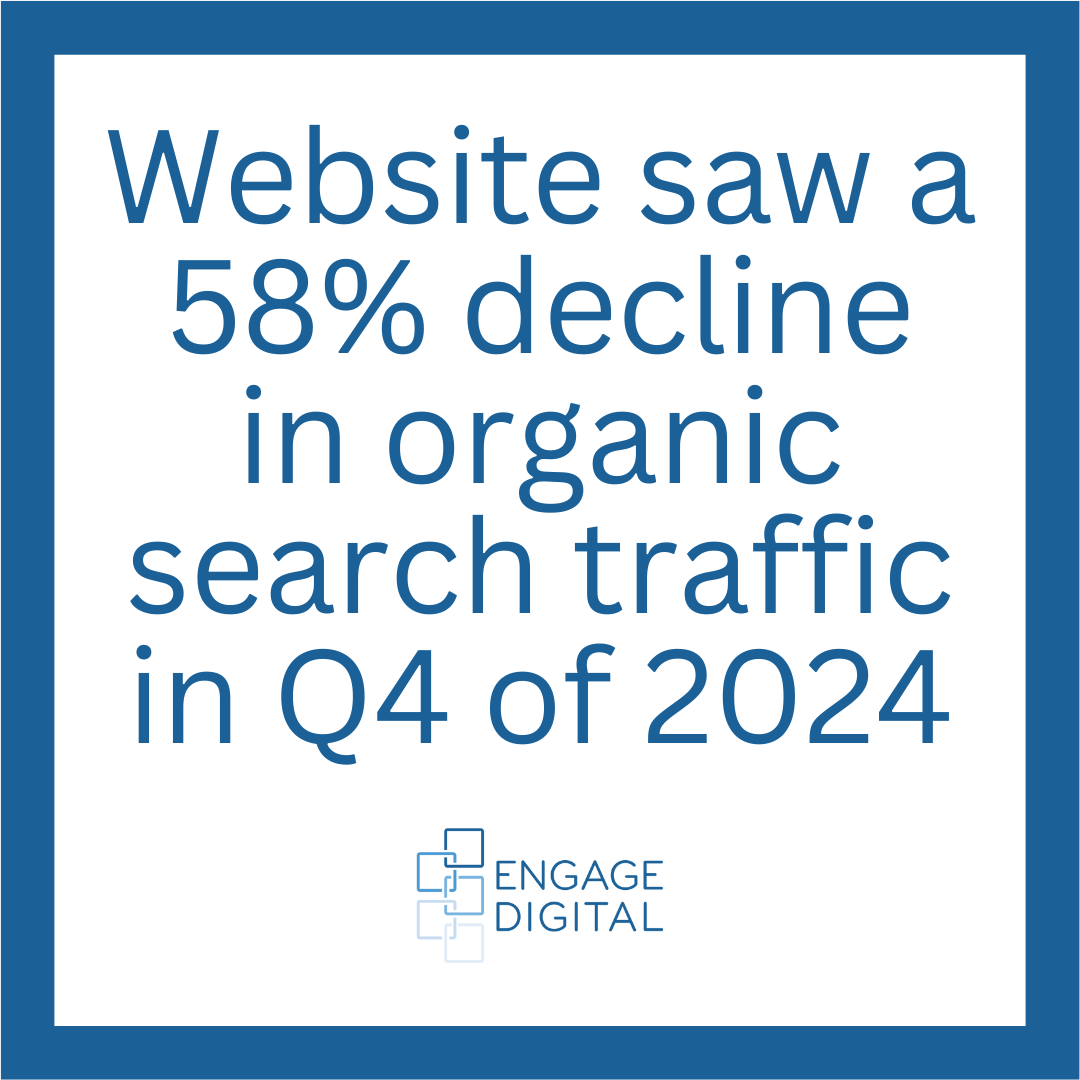Toward the end of 2024, many website owners were blindsided.
Traffic dropped. Rankings slipped. Leads dried up. 
According to multiple industry reports, the average U.S. website saw a 58% decline in organic search traffic in Q4 of 2024. Globally, that figure sat around 52%. For many brands, this wasn’t just a minor dip—it was a crushing blow that wiped out years of SEO gains.
So, what caused it?
Let’s examine the underlying reasons behind the decline and how to move forward with a more effective SEO strategy tailored for 2025 and beyond.
Understanding Why Your SEO Traffic Dropped
A sudden loss in organic traffic is rarely random. It’s usually a signal that something fundamental has changed—either on your site, in your industry, or within the search engine algorithm.
In late 2024, a combination of factors created the perfect storm.
1. The Rise of AI-Powered Search
Search engines no longer operate the way they used to.
Google’s AI Overviews, Microsoft’s Bing Copilot, and tools like Perplexity AI now answer user queries directly, without requiring them to click through to a website. This change has drastically reduced the number of clicks traditional search results receive.
Instead of listing 10 blue links, search engines are now displaying full AI-generated summaries that pull from multiple sources. In many cases, users never scroll down to the organic results.
This change in user behavior is measurable. A 2025 SparkToro study found that over 61% of Google searches now end without a click, a number expected to increase to over 80% within a year. That’s a massive shift from just two years ago, when most users clicked through to at least one result.
2. Content Overload Diluting Rankings
AI has also transformed the way content is created.
Thanks to generative tools like ChatGPT and Jasper, there’s now more content being published than ever before. That might sound good, but it means more competition for the same top spots in search results.
Even highly authoritative sites are being pushed down by floods of semi-relevant, AI-generated content that’s optimized with keyword tools and content farms.
As a result, it’s harder to hold onto high-ranking positions, even with quality content.
3. Algorithm Shifts and Core Updates
Google rolled out multiple major core updates in late 2024. These updates focused heavily on:
- Content quality and originality
- Page speed and Core Web Vitals
- User experience and engagement metrics
- EEAT (Experience, Expertise, Authoritativeness, and Trustworthiness)
Websites that had previously ranked well—even those with solid backlinks and keyword strategy—saw dramatic shifts if they didn’t meet these new expectations.
According to SEMrush Sensor, algorithm volatility scores in December 2024 were at their highest in over 5 years.
Diagnosing the Damage the Right Way
If your traffic dived, don’t panic. You’re not alone, and there are innovative ways to audit and recover.
Step 1: Compare Year-Over-Year and Month-Over-Month Trends
Start with Google Analytics and Search Console. Compare the past 12 months and look for:
- Drops in impressions or clicks from organic search
- Specific pages or keywords that lost rankings
- Significant declines from mobile vs. desktop
This helps isolate whether the issue is site-wide or tied to certain content types or devices.
Step 2: Identify Traffic Loss by Search Type
Break down traffic by search category:
- Traditional SEO
- Voice search
- Image search
- AI overviews and zero-click results
You may find your voice search visibility has disappeared or AI-generated responses have replaced your snippets.
Step 3: Check Page Experience and Core Web Vitals
Use PageSpeed Insights or Lighthouse to review your site performance.
If your Largest Contentful Paint (LCP) or Cumulative Layout Shift (CLS) scores are poor, you’re likely being penalized. A slow-loading or jumpy page equals a bad user experience—and a hefty SEO penalty.
Rethinking the Goal: It’s Not About Going Back
Here’s the hard truth: SEO in 2023 is not coming back.
Even with perfect on-page and technical SEO, the landscape has undergone significant changes. There are fewer total clicks to be had because AI is consuming many of them.
So don’t try to “recover” old traffic levels. Instead, start building new growth from your current baseline.
Think of it as a rebuild, not a recovery.
What Businesses Should Focus on Next
1. Optimize for AI and Voice Search
Voice search is expected to account for over 50% of all mobile searches in 2025. This means your content must clearly and concisely answer questions.
Use structured data and schema markup. Create FAQ sections. Write in a conversational tone that’s easy to read aloud.
If AI tools are going to summarize your page, make sure they’re pulling the correct information.
2. Go Deep, Not Wide With Content
Instead of publishing dozens of average posts, focus on a few beneficial ones.
Cover topics comprehensively. Include charts, stats, comparisons, and visuals. Make your content worth quoting by AI tools and linking to by other websites.
In 2025, one great page can outperform 20 average ones.
3. Prioritize Speed and UX
Page experience matters more than ever.
- Use compressed images and modern formats (like WebP)
- Keep the total page size under 2MB
- Design mobile-first layouts
- Avoid excessive ads and pop-ups
- Fast, clean pages rank better and retain users longer.
4. Build Topical Authority and Originality
Google’s new ranking models favor authors with real-world expertise. Focus on:
- Author bios that show credentials
- First-hand examples or case studies
- Citing original research or running your own
- Avoid generic content. Stand out by saying something unique.
Don’t Just SEO—AI-O
In the future, your content should be written not just for humans or Google, but for AI intermediaries that sit between users and websites.
Whether it’s Google’s SGE, Bing Copilot, or ChatGPT with browsing, your content must be:
- Fast-loading
- Structured
- Factually accurate
- Visually enhanced
- Easy to summarize
Your job is to feed the algorithm what it wants, before it starts ignoring your site altogether.
The decline in SEO traffic is real, and in some cases, irreversible. However, that doesn’t mean your digital marketing efforts are doomed. With an innovative, forward-looking strategy, you can reclaim visibility and build new momentum. Use data to diagnose. Use AI to adapt. And start creating co






